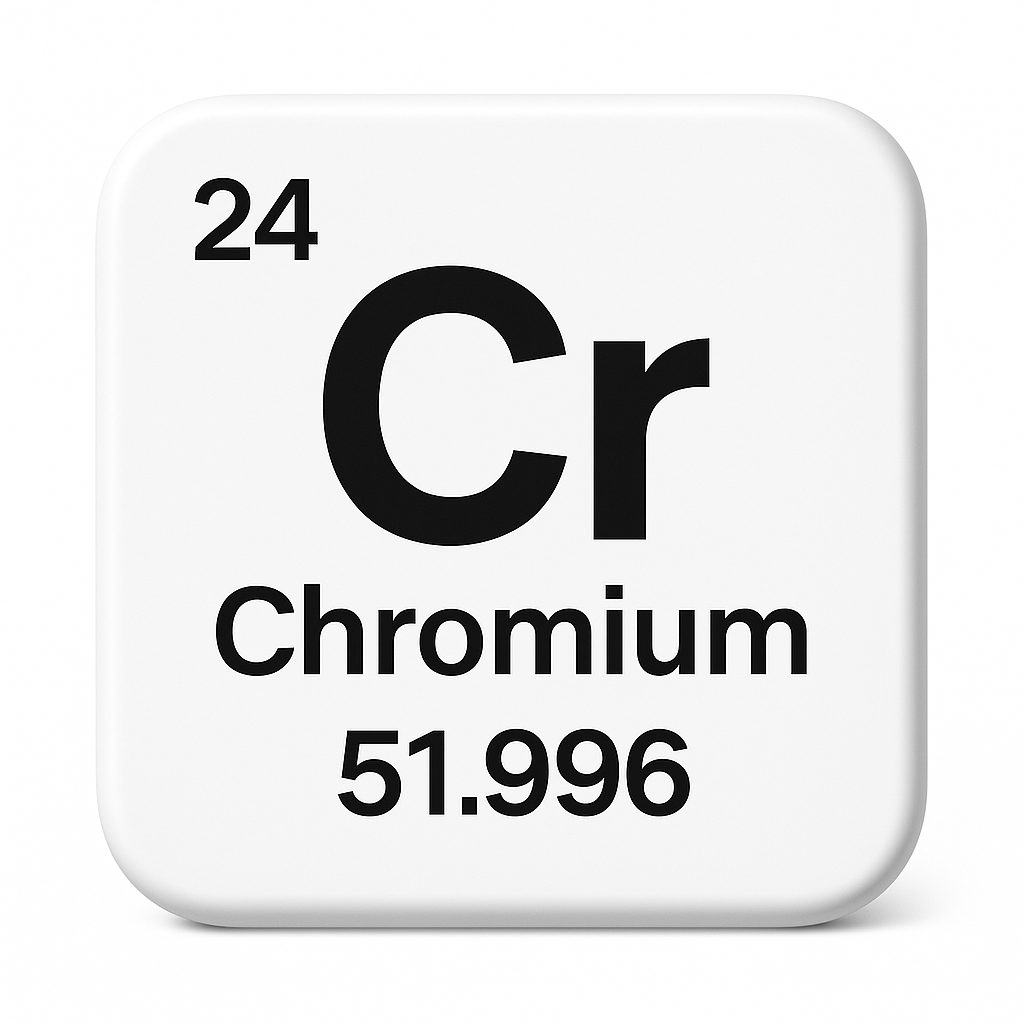Resources
Glossary
Chromium (Cr)
Chromium is a hard, lustrous metallic element (chemical symbol Cr, atomic number 24) known for its exceptional corrosion resistance, hardness, and shiny, silvery appearance. It is one of the key alloying elements in many steels—especially stainless steel and chromoly (chromium-molybdenum) alloys—and plays a vital role in improving strength, surface durability, and oxidation resistance.
In metallurgy, chromium serves several important functions:
Corrosion and Oxidation Resistance:
When chromium is added to steel (usually at least 10.5%), it reacts with oxygen in the air to form a thin, stable layer of chromium oxide (Cr₂O₃). This invisible film protects the underlying metal from rusting, which is why stainless steel doesn’t corrode easily.
Hardness and Wear Resistance:
Chromium increases a metal’s surface hardness and resistance to abrasion. This makes it useful for tool steels, bearings, and fasteners that experience friction, impact, or wear.
High-Temperature Strength:
Chromium helps metals maintain their strength and oxidation resistance at elevated temperatures—important for exhaust systems, turbines, and high-heat industrial equipment.
Aesthetic and Protective Coatings:
Chrome plating (electroplating a thin layer of chromium onto another metal) gives parts a mirror-like finish while improving wear and corrosion resistance. This is common on decorative hardware, automotive trim, and tools.
In its pure form, chromium is steel-gray, brittle, and highly polished. Industrially, it’s produced from chromite ore (FeCr₂O₄) and is used not only in metal alloys but also in pigments, refractory materials, and catalysts.

Chromium Ore
Chromium ore is the natural mineral source of chromium, an essential metallic element used to make stainless steel, superalloys, and industrial coatings. The main chromium ore is chromite, with the chemical formula FeCr₂O₄—an iron chromium oxide. It’s the only commercially significant ore of chromium and the raw material from which nearly all chromium-based metals, chemicals, and alloys are derived.

Composition and Structure
Chromite is a hard, dense, black-to-brownish-black mineral belonging to the spinel group. Its structure consists of:
- Iron (Fe²⁺) ions occupying one set of sites,
- Chromium (Cr³⁺) ions occupying another,
- and oxygen (O²⁻) forming the lattice.
The general chemical formula can vary slightly due to natural substitutions—magnesium, aluminum, and other elements often replace some of the iron and chromium atoms, resulting in slight compositional differences depending on the deposit.
Processing and Production
After mining, chromite ore is refined through several steps:
- Concentration: Crushing, grinding, and separating the chromite from gangue minerals.
- Smelting: In a ferrochrome furnace, chromite is combined with carbon (usually coke) and fluxes to produce ferrochrome (FeCr)—an alloy of iron and chromium.
- Refining: The ferrochrome is then used in stainless steel and other chromium-containing alloys.
Industrial Uses of Chromium Derived from Ore
- Stainless steel: Chromium gives steel its corrosion resistance and shiny finish.
- Alloy steels: Improves hardness, wear resistance, and high-temperature strength.
- Electroplating (chrome plating): For decorative and protective coatings.
- Pigments: Produces vivid green, yellow, and red colors in paints, ceramics, and glass.
- Refractory materials: Used to line furnaces because of its heat resistance.
Chromium Oxide
Chromium oxide refers primarily to chromium(III) oxide, with the chemical formula Cr₂O₃. It’s a dark green, extremely stable compound that forms when chromium reacts with oxygen. This oxide is one of the most important and naturally occurring compounds of chromium—it’s the same protective film that makes stainless steel “stainless.”

Formation and Structure
When chromium in an alloy (like stainless steel or chromoly) is exposed to air, it reacts with oxygen to form a thin, dense, self-healing layer of Cr₂O₃ on the metal’s surface. This layer is only a few atoms thick, but it’s chemically inert and adheres tightly, preventing oxygen and moisture from reaching the metal beneath.
This process is known as passivation, and it’s why stainless steels and chromium-plated parts resist rust and corrosion far better than carbon steel.
Properties
- Chemical formula: Cr₂O₃
- Color: Deep green (also used as a pigment known as chromium green or chrome oxide green)
- Melting point: ~2,435°C (4,415°F)
- Hardness: Very high—used as an abrasive and in polishing compounds
- Chemical stability: Resistant to acids, bases, and oxidation
Industrial and Engineering Uses
Corrosion Protection:
The protective oxide film on chromium-bearing metals shields fasteners, tools, and machinery from rust.
Pigments and Coatings:
Used in paints, ceramics, and glass as a durable green pigment.
Polishing and Abrasives:
Finely ground chromium oxide is used in metal polishing compounds (“green rouge”).
Refractory Applications:
Its heat resistance makes it ideal for furnace linings and ceramics.
In Fasteners and Alloys
In fastener materials like stainless steel, chromium-molybdenum (chromoly) steel, and plated bolts, chromium oxide is what prevents corrosion. If the surface is scratched, the oxide layer re-forms automatically, sealing the exposed metal—making it a key reason why chromium-alloyed steels have such long service lives.
Hexavalent Chromium
Hexavalent chromium (Cr⁶⁺) is a toxic, high-oxidation state of the element chromium. It is commonly found in industrial processes, coatings, and chemical compounds. Unlike trivalent chromium (Cr³⁺), which is an essential nutrient in small amounts, hexavalent chromium is hazardous to human health and the environment.

In industrial applications, hexavalent chromium compounds are used for electroplating, stainless steel production, corrosion-resistant coatings, pigments, dyes, and wood preservatives. Its strong oxidative properties make it highly effective for creating durable and protective finishes on metals, which is why it has historically been widely used in fastener coatings and plating.

Health and safety concerns are significant with hexavalent chromium. It is recognized as a carcinogen, capable of causing lung cancer, respiratory problems, and skin irritation upon prolonged exposure. Inhalation of hexavalent chromium particles is especially dangerous, and strict occupational safety regulations limit worker exposure. Many industries have moved toward safer alternatives, such as trivalent chromium coatings or non-chromium-based finishes, to reduce risks.
Environmental regulations, including those from OSHA, EPA, and the European Union’s RoHS and REACH directives, have heavily restricted the use of hexavalent chromium in recent years. Despite its effectiveness as a corrosion inhibitor, the toxic nature of Cr⁶⁺ has made the transition to safer coatings a priority for manufacturers, particularly in fastener production and surface finishing.
Trivalent Chromium (Cr³⁺)
Trivalent chromium (Cr³⁺) is a chemical form of the element chromium in which each atom has an oxidation state of +3. It is one of the most stable and naturally occurring states of chromium and is considered an essential trace nutrient for humans, since it plays a role in regulating blood sugar by enhancing the action of insulin. In the environment, trivalent chromium is far less toxic than hexavalent chromium (Cr⁶⁺), which is highly hazardous.

In industrial applications, trivalent chromium is widely used in coatings, plating, and passivation processes. For example, it serves as an alternative to hexavalent chromium in chrome plating, providing corrosion resistance and an attractive finish while meeting stricter environmental and worker-safety regulations. Trivalent chromium compounds are also used in dyes, pigments, tanning leather, and catalysts.

From a safety standpoint, Cr³⁺ is generally much safer than Cr⁶⁺ because it does not penetrate biological membranes as easily and is less likely to cause genetic or cellular damage. However, exposure to high concentrations of trivalent chromium compounds can still cause health and environmental concerns, so proper handling is important.
